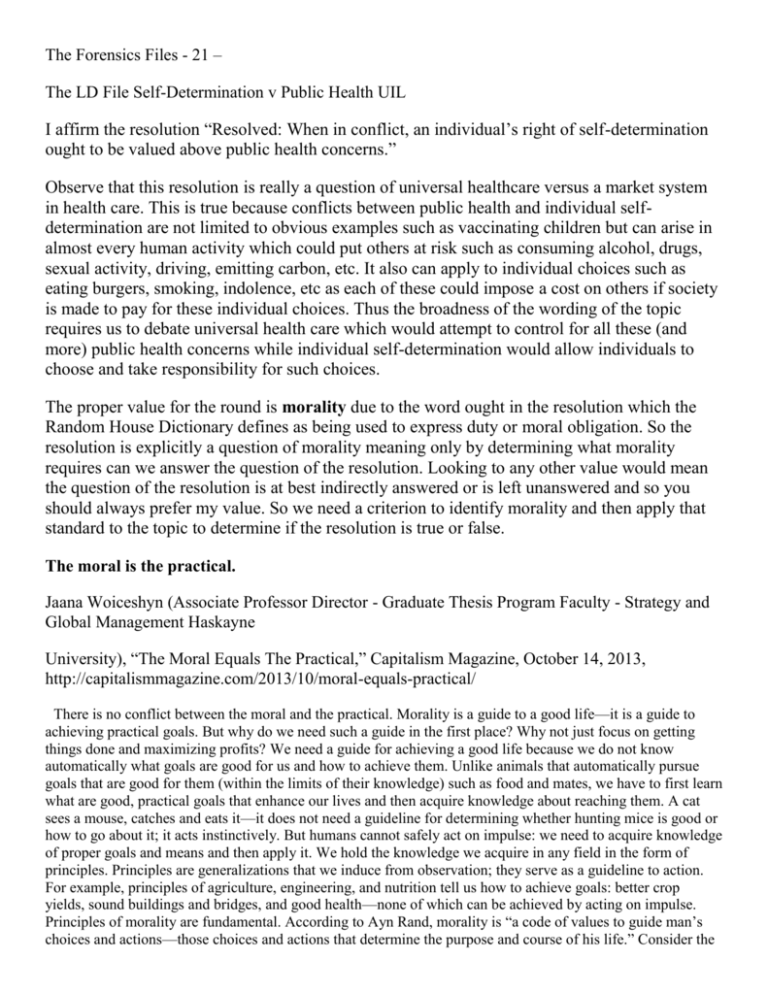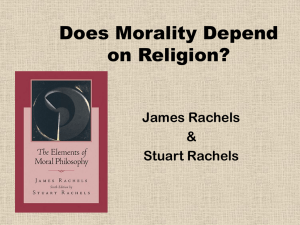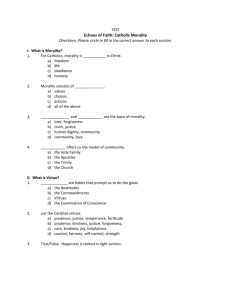morality
advertisement

The Forensics Files - 21 – The LD File Self-Determination v Public Health UIL I affirm the resolution “Resolved: When in conflict, an individual’s right of self-determination ought to be valued above public health concerns.” Observe that this resolution is really a question of universal healthcare versus a market system in health care. This is true because conflicts between public health and individual selfdetermination are not limited to obvious examples such as vaccinating children but can arise in almost every human activity which could put others at risk such as consuming alcohol, drugs, sexual activity, driving, emitting carbon, etc. It also can apply to individual choices such as eating burgers, smoking, indolence, etc as each of these could impose a cost on others if society is made to pay for these individual choices. Thus the broadness of the wording of the topic requires us to debate universal health care which would attempt to control for all these (and more) public health concerns while individual self-determination would allow individuals to choose and take responsibility for such choices. The proper value for the round is morality due to the word ought in the resolution which the Random House Dictionary defines as being used to express duty or moral obligation. So the resolution is explicitly a question of morality meaning only by determining what morality requires can we answer the question of the resolution. Looking to any other value would mean the question of the resolution is at best indirectly answered or is left unanswered and so you should always prefer my value. So we need a criterion to identify morality and then apply that standard to the topic to determine if the resolution is true or false. The moral is the practical. Jaana Woiceshyn (Associate Professor Director - Graduate Thesis Program Faculty - Strategy and Global Management Haskayne University), “The Moral Equals The Practical,” Capitalism Magazine, October 14, 2013, http://capitalismmagazine.com/2013/10/moral-equals-practical/ There is no conflict between the moral and the practical. Morality is a guide to a good life—it is a guide to achieving practical goals. But why do we need such a guide in the first place? Why not just focus on getting things done and maximizing profits? We need a guide for achieving a good life because we do not know automatically what goals are good for us and how to achieve them. Unlike animals that automatically pursue goals that are good for them (within the limits of their knowledge) such as food and mates, we have to first learn what are good, practical goals that enhance our lives and then acquire knowledge about reaching them. A cat sees a mouse, catches and eats it—it does not need a guideline for determining whether hunting mice is good or how to go about it; it acts instinctively. But humans cannot safely act on impulse: we need to acquire knowledge of proper goals and means and then apply it. We hold the knowledge we acquire in any field in the form of principles. Principles are generalizations that we induce from observation; they serve as a guideline to action. For example, principles of agriculture, engineering, and nutrition tell us how to achieve goals: better crop yields, sound buildings and bridges, and good health—none of which can be achieved by acting on impulse. Principles of morality are fundamental. According to Ayn Rand, morality is “a code of values to guide man’s choices and actions—those choices and actions that determine the purpose and course of his life.” Consider the principle of honesty: whether you choose to follow it or select a career as a con artist, will determine the purpose and course of your life. Similarly, if you follow the principle of self-interest, the purpose and course of your life will differ dramatically from those who follow the principle of self-sacrifice. If we want to achieve a good life, we need to identify and choose the moral principles that support it. Why do many people think that the moral and the practical conflict? The confusion stems from the prevailing view of morality: altruism. Most are not aware of the morality of self-interest. Instead, they believe that to be moral, one must put others’ interests ahead of their own. Yet, they realize they must be practical and achieve at least some of their values, such and food and shelter, to survive. If you practice altruism on principle, you will have to give up all your values—which is impractical, if you want to live. Naturally, the goal of business—profit maximization—is incompatible with altruism. The impossibility of following altruism in business (and in life in general) leads many to accept the false alternative of pragmatism: rejecting all principles and doing whatever they feel is practical to “get things done.” The problem with this approach is that it prevents us from achieving long-term profitability and other goals. As fallible beings without automatic knowledge, we need the guidance of moral principles. Compromising them for so-called “practical” ends will not lead to achievement of values but to their loss, as those compromising principles such as honesty by deceiving investors or cutting corners in product quality will eventually find out. So the criterion for the round becomes identifying the practical approach to health. In other words if freedom solves better for health concerns than it is the moral approach. If it does not, it is not the moral approach. So if I prove that freedom does solve better than you can affirm as the prioritizing individual selfdetermination is then moral and so the resolution is true. I contend that prioritizing individual self-determination solves for health concerns while government intervention for public health undermines health. 1. Government intervention for public health in the health market is inherently flawed and doomed to fail. Lin Zinser (Director of Public Outreach at Ayn Rand Center for Individual Rights) & Paul Hsieh (physician & co-founder of Freedom and Individual Rights in Medicine (FIRM)), “Moral Health Care vs. ‘Universal Health Care,’” The Objective Standard, Vol 2, No 4, Winter 2007, https://www.theobjectivestandard.com/issues/2007-winter/moral-vs-universal-health-care/ Government-run health care systems do not and cannot work, because they improperly treat health care as a “right.” Health care, like food and clothing, is a need, but not a right. It is a commodity that is created by the intelligent thought, creativity, and hard work of producers, such as doctors, nurses, allied medical professionals, and hospital administrators. When the government treats health care as a right, it necessarily violates the genuine rights of the providers who produce those goods and should be free to offer them for exchange on whatever terms they see fit, not forced to serve people against their own judgment. And it necessarily violates the rights of consumers, who should be free to trade with providers by mutual consent to mutual benefit. As we have seen repeatedly, good doctors cannot and will not continue working under a system that enslaves them. This means that government intervention in the health market for public health cannot possibly work and so is not practical and so you can affirm. 2. Government intervention for public health in the health market is the root cause of America’s health issues. Lin Zinser (Director of Public Outreach at Ayn Rand Center for Individual Rights) & Paul Hsieh (physician & co-founder of Freedom and Individual Rights in Medicine (FIRM)), “Moral Health Care vs. ‘Universal Health Care,’” The Objective Standard, Vol 2, No 4, Winter 2007, https://www.theobjectivestandard.com/issues/2007winter/moral-vs-universal-health-care/ The solution to America’s health care problems is not more government intervention. Government violations of individual rights through government interference in the marketplace are the source of the problems. Government meddling in health insurance has all but eliminated choice, competition, and innovation, and has driven up the cost of health insurance. Government interference in medicine has caused incalculable harm to both patients and doctors, and driven up the cost of health care. Government controls have bred more controls, as politicians and bureaucrats have tried to “solve” the problems created by one set of regulations by imposing another set, and so forth, in a vicious spiral of increased costs, rationing, suffering, and death. Just as a doctor would not attempt to treat a burn victim by exposing him to more heat, so we should not attempt to solve our health care problems through more government intervention. This means that every harm the affirmative can point to in the current system is actually caused by government intervention in the health market for public health proving intervention is not practical and so you can affirm. 3. Empirically, freer health markets lead to greater innovation and lower costs. Lin Zinser (Director of Public Outreach at Ayn Rand Center for Individual Rights) & Paul Hsieh (physician & co-founder of Freedom and Individual Rights in Medicine (FIRM)), “Moral Health Care vs. ‘Universal Health Care,’” The Objective Standard, Vol 2, No 4, Winter 2007, https://www.theobjectivestandard.com/issues/2007-winter/moral-vs-universal-health-care/ Only the ideal of the free market—based on the principle of individual rights—provides a solid foundation for genuine and practical reform. And only a free market in medicine can deliver the properly (i.e., voluntarily) priced high-quality health care that Americans deserve. This last point is evident in the sectors of medicine with the least government regulation, such as cosmetic surgery and LASIK eye surgery. The clear pattern in these sectors is a continual decrease in prices and improvement in quality. As health economist Devon Herrick stated in testimony before the U.S. Congress: [D]espite a marked increase in demand between 1992 and the present, cosmetic surgeons’ fees remained relatively stable. The average increase in prices for medical services from 1992 through 2005 was 77 percent. The increase in the price of all goods, as measured by the consumer price index (CPI), was 39 percent. Cosmetic surgery prices only went up about 22 percent. Thus, while the price of medical services generally rose almost twice as fast as the CPI, the price of cosmetic surgery went up slightly more than half as much. Put another way, while the real price of health care paid for by third parties rose, the real price of self-pay medicine fell. Another example of price competition is the market for corrective eye surgery. In 1999, only a few years after LASIK was approved, the price was about $2,100 per eye, according to the ophthalmic market research firm MarketScope. Within a short time, competition drove the price down to slightly more than $1,600. The cost per eye of the standard LASIK is now about 20 percent lower than six years earlier. Competition held prices in check until a new innovation arrived for which patients were willing to pay more. By 2003 surgeons began to perform a newer, more-advanced custom wavefront-guided LASIK procedure.69 In other words, the market can and does bring down health care costs while improving services when allowed to operate without government interference. This means respecting freedom, meaning protecting the right to self-determination, does solve for health concerns and so it is practical meaning you can affirm.








